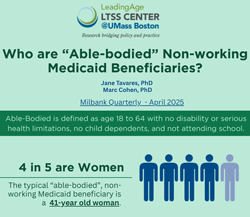Who are “Able-Bodied” Non-Working Medicaid Beneficiaries?
Jane Tavares, PhD, adjunct instructor, University of Massachusetts Boston
Marc A. Cohen, PhD, co-director of the LeadingAge LTSS Center at UMass Boston
About:
This infographic visually represents the individuals who will be affected by the proposed Medicaid work requirements. Under the proposed legislation, individuals aged 18 to 64 who are deemed “able-bodied” would be required to work to be eligible for the program. The proposed cuts to the Medicaid program are estimated to result in nearly 14 million Americans being uninsured.
Our Approach:
The LTSS Center analyzed the 2023 American Community Survey of the U.S. Census to identify Medicaid beneficiaries who would be considered “able-bodied” under the proposed legislation. This includes individuals aged 18 to 64 who are not currently employed, have no disabilities or serious health limitations, have no child dependents, and are not currently enrolled in school.
Key Takeaways:
Our research revealed that those who are considered “able-bodied” are predominantly middle-aged-to-older women who are exceptionally impoverished, have low levels of education, and left the workforce to care for their families. The data show that most “able-bodied” individuals are age 50 and older, an age group that typically has the greatest need for services and supports through programs like Medicaid.
How to Use this Resource:
The infographic provides aging and disability advocates, policymakers, and the public with fact-based information about who will be impacted by cuts to the Medicaid program.

